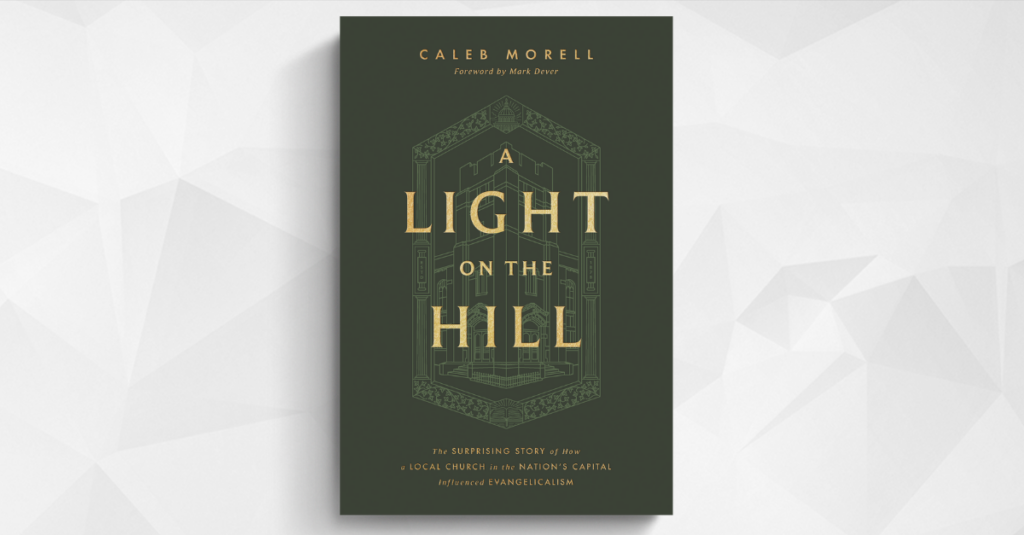New Book “A Light on the Hill” Is More Than Meets the Eye
April 2, 2025

April 2, 2025
Caleb Morell,
Marsden on Edwards, Murray on Spurgeon, Bainton on Luther—who doesn’t love a good biography? But what if I told you that one of my new favorite biographies isn’t about a person but about God’s faithfulness in a church?
I admit that when I received my copy of Caleb Morell’s A Light on the Hill, I was perplexed. “Isn’t it a bit early to write about Mark Dever’s legacy? . . . I’ve also never read a history of a local church that didn’t put me to sleep.” But to my pleasant surprise, there is more going on in this book than meets the eye.
For 150 years, Capitol Hill Baptist Church has stood as a beacon of gospel faithfulness in the heart of Washington, D.C. It has endured war, division, racial strife, and cultural upheaval as the sands of time shifted around it. In A Light on the Hill, Caleb Morell shows us that, more than anything, God has used the lives of ordinary saints to keep a gospel light burning in the heart of the nation’s capital.
This story of God’s great grace on Capitol Hill begins in 1867 in a humble prayer meeting organized by Celestia Ferris, a saint who saw a need and did the only thing she knew to do—go to God in prayer. Morell moves the reader through the story of CHBC by examining the words and works of several other faithful saints on the Hill.
Consider, for example, Agnes Shankle, the Sunday School teacher who, in 1944, stood up in a member’s meeting to oppose the appointment of a modernist pastor. Or consider Margaret Roy, the first African-American member of the church. In 1969, after significant racial turmoil in the city, Margaret walked through the church doors with a commitment to join the all-white congregation, resolved to treat others right, regardless of how she was treated.
Or consider Bill, the deacon who refused to let the church die when everyone else was willing to walk away. Bill fought many battles to keep the light of the gospel alive in Capitol Hill—financial, theological, and personal. One of the most heartbreaking stories of the book is of Bill trusting the Lord to bring justice when his wife was taken advantage of by the pastor. In a particularly low moment, not knowing up from down amid terrible pain and grief, Bill simply prayed, “Commit your way to the Lord; trust in him, and he will act” (Ps. 37:5).
It was another church member, Matt Schmucker, who worked with the deacon board to ensure that the appropriate steps were taken to remove the disqualified pastor from the body. (Schmucker would become the future co-founder of 9Marks.)
Finally, it was long-time church member Carl F.H. Henry, founding editor of Christianity Today, who wrote Mark Dever a letter at Cambridge urging him to consider pastoring CHBC.
Of course, this brief smattering of stories doesn’t even begin to cover the depths of God’s grace to CHBC through scores of faithful saints—pastors, deacons, and members alike. It reminds me that God is always doing more than meets the eye. As Morell writes in the introduction, “This story is about God and how he delights to do extraordinary things through ordinary people and ordinary churches.”
The story of Capitol Hill Baptist Church is, in one sense, exceptional. But in another sense, it is the story of every faithful gospel-preaching, Bible-believing, Christ-exalting congregation—ups and downs, highs and lows, strengths and weaknesses, faithful shepherds and wolves in sheep’s clothing. It’s the story of every true church from the days of the apostles to our own—grace, grace, and more grace.
I could perceive the power of the Holy Spirit at work in the life of this church as I read her story on every page. I believe you will, too. This is a book that will inspire pastors, encourage members, surprise critics, and strengthen churches.